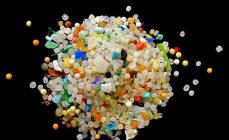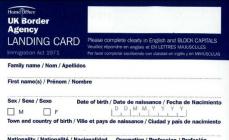Contrary to popular belief, the Great Pacific Garbage Spot is not a huge island of solid garbage floating in the Pacific Ocean, but rather a limitless, almost immeasurable soup of microscopic debris.
Most of this garbage comes from North America or Asia. With the help of ocean currents, garbage accumulates in certain areas of the Pacific Ocean.
Several ocean currents converge in the North Pacific Current, which is a system of rotating ocean currents caused by wind and inertia.
The large Pacific trash spot actually consists of two parts:
Large Pacific trash spot on the map
- Western Pacific garbage spot, located near Japan;
- An East Pacific garbage spot that sits between the west coast of the United States and the Hawaiian Islands.
Microplastic

Fine plastic particles
A large Pacific trash stain consists mainly of microplastics or microscopic plastic particles. Despite some differences over size, the National Oceanic and Atmospheric Administration calls microplastic particles of plastic with a diameter of less than 5 mm. They can come from a variety of sources, including cosmetics, clothing, and industrial processes.
Currently, there are two classifications of microplastics:
- primary microplastics are a direct result of the use of human products;
- secondary microplastics are microscopic plastic particles obtained as a result of the destruction of larger plastic debris, such as macroscopic parts, which make up the bulk of the Great Pacific Garbage Spot.
Both types are known to be stored in the environment in large quantities, especially in water and water.
Since plastic does not deteriorate over many years, it becomes a part and accumulates in the tissues of many organisms. The entire cycle and movement of microplastics in the environment has not yet been studied, but research is currently underway on this issue.
What does it consist of?
A large Pacific trash spot consists of:
- Plastics: which makes up about 80% of the garbage. Plastic is a cheap and one of the most common synthetic materials, and due to its durability and versatility, it is popular among people and also in industry. Plastic usually cannot be destroyed by living organisms, which means that when it is in the ocean, it remains there, being degraded and broken into small pieces, but does not completely disappear. Some of the particles are extremely small - these beads create many problems for the wild.
- Big debris:comprising about 20% of garbage, mainly comes from fishing operations, offshore oil rigs or ship spills.
- Sunken trash.Recently, oceanographers estimate that up to 70% of marine debris is not on the surface, but at the bottom of the ocean.
Environmental impact

The impact of the Great Pacific Garbage Spot is massive and catastrophic. Marine wildlife is most susceptible to adverse effects. A few examples include:
- Sea turtles mistakenly hunt for plastic bags, mistaking them for jellyfish or other marine prey.
- Albatrosses and other seabirds who accidentally eat pieces of plastic die from starvation and dehydration.
- Seals and other marine mammals often end up in abandoned fishing nets.
- Filtrators consume plastic particles instead of ordinary plankton or fish eggs.
Floating plastic can also prevent sunlight from entering plankton or algae, the microscopic organisms that are at the base of the entire sea. If plankton is reduced, the animals that eat it, such as turtles or fish, will also be reduced in numbers. A reduction in the populations of turtles and fish will affect the number of overpredators such as sharks and whales.
Impact on human life:
- If marine food chains are disrupted, fish and other seafood will become less accessible to humans or more expensive.
- Plastic contains chemicals such as bisphenol A, which cause environmental and human health problems. Polychlorinated biphenyl is known to be found in plastic and can accumulate to toxic levels in marine ecosystems and in people who eat seafood.
Possible solutions to the problem

Scientists have studied the Great Pacific Trash Spot and have discovered several effective solutions for cleaning the ocean. However, the main problem is that this contaminated area is quite large and is located far from the coast, so no country in the world has begun to clean it. The Pacific Ocean is too deep to reach the bottom, and the nets are small to capture trash, and marine life can inadvertently get into them. Scientists agree that the best solution for cleaning the Great Pacific Garbage Stain is to reduce the use of plastics and encourage the use of biodegradable and reusable materials.
If you find an error, please select a piece of text and press Ctrl + Enter.

A large Pacific garbage spot (English Eastern Garbage Patch - Eastern garbage continent) - a huge accumulation of garbage in the northern part of the Pacific Ocean. The stain consists of plastic and other man-made wastes that were picked up by a circular current in the North Pacific. Despite its size and considerable density, the spot is not visible in satellite photographs, since it consists of small particles. In addition, most of the garbage floats in a slightly recessed state, hiding under water.
The existence of the garbage continent was theoretically predicted back in 1988. The forecast was based on data obtained in Alaska between 1985 and 1988. A study of the amount of drifting plastic in the surface waters of the northern part of the Pacific Ocean revealed that a lot of garbage accumulates in areas subject to certain ocean currents. Data from the Sea of \u200b\u200bJapan allowed researchers to suggest that such clusters can be found in other parts of the Pacific Ocean, where the prevailing currents contribute to the formation of a relatively calm water surface. In particular, scientists pointed to the North Pacific Current System. A few years later, the existence of a huge garbage spot was documented by Charles Moore, a California captain and explorer of the sea. Sailing the North Pacific Current System after participating in the regatta, Moore discovered a huge accumulation of debris on the surface of the ocean. Captain Moore reported his find to oceanographer Curtis Ebbesmeyer, who later called this area the Eastern Trash Continent. The fact of the existence of the garbage spot attracted the attention of the public and academia after the publication of several articles by Charles Moore. Since then, a large garbage spot has been considered the largest example of human pollution of the marine environment.

Like other high debris areas of the World Ocean, a large Pacific debris spot was formed by ocean currents, gradually concentrating debris thrown into the ocean in one area. The garbage spot occupies a large, relatively stable area in the North Pacific Ocean, limited by the North Pacific Current System (an area often referred to as “horse latitudes,” or calm latitudes). The whirlpool system collects garbage from all over the North Pacific, including from the coastal waters of North America and Japan. Waste is picked up by surface currents and gradually moves to the center of the maelstrom, which does not let garbage out of its limits.

The exact size of the large spot is unknown. It is impossible to estimate its size from the side of the ship, but the spot is not visible from the side of the aircraft. Most of the information about the garbage spot we can get only from theoretical calculations. Estimates of its area vary from 700 thousand to 15 million km² or more, (from 0.41% to 8.1% of the total area of \u200b\u200bthe Pacific Ocean). There are probably more than one hundred million tons of garbage on this site. It is also speculated that the garbage continent consists of two combined sites.
According to Charles Moore, 80% of the garbage in the stain comes from ground sources, 20% is thrown from the decks of ships located on the high seas. Moore claims that waste from the east coast of Asia moves to the center of the maelstrom in about five years, and from the west coast of North America in a year or less.

A garbage stain is not a continuous layer of debris floating on the surface itself. The particles of decomposed plastic are for the most part too small to be visually visible. For a rough estimate of the density of pollution, scientists examine water samples. In 2001, scientists (including Moore) found that in certain areas of the garbage spot, plastic concentration already reached a million particles per square mile. There were 3.34 pieces of plastic with an average weight of 5.1 milligrams per square meter. In many places of the infected region, the total concentration of plastic exceeded the concentration of zooplankton by seven times. In samples taken at greater depths, the level of plastic waste was significantly lower (mainly fishing lines). Thus, previous observations were confirmed, according to which most of the plastic waste is collected in the upper water layers.
Some plastic particles resemble zooplankton, and jellyfish or fish can take them for food. A large amount of hard-to-decompose plastic (caps and rings from bottles, disposable lighters) is found in the stomachs of seabirds and animals, in particular sea turtles and black-footed albatrosses.

Thus, humanity once again created a problem for itself. A significant part of the plastic decomposes very slowly. For example, for the biodegradation of polyethylene it takes about two hundred years; polyvinyl chloride releases unsafe products upon decomposition. Measures are planned to clean the surface of the ocean using fleets of specially equipped ships, but this is difficult to implement in practice, and, in addition, the collected garbage still needs to be recycled. If we cannot solve the problem, do not at least aggravate it. The first thing to do is to reduce the flow of garbage into the ocean and increase the production of packaging from biodegradable plastic grades.
Clogging water bodies with human waste is one of the burning problems of our time. Part of the garbage decomposes over time, but its considerable mass settles to the bottom or stays floating on the water surface, causing enormous damage to the environment.
Huge accumulations of garbage, resembling islands or even entire continents in size, are often found in the Pacific, Indian, Atlantic oceans. Researchers of this phenomenon compare it with “garbage soup”: part of the waste does not sink, but floats on the surface or in the water column — and such “spots” of garbage stretch for many kilometers.
Where does such a large amount of human waste come from in the ocean?
First of all, this is what is thrown into the water by residents and visitors of cities located in close proximity to the seas.
For example, ecologists call India, Thailand and China, the leaders polluting waters with garbage, where dumping into the rivers and seas all that is unnecessary is considered almost the norm.

Especially active and thoughtlessly usually litter tourists resting on the warm sea coasts of the world. From them, cigarette butts, plastic bottles and cans from various drinks, glasses, corks, plastic bags, disposable tableware, cocktail tubes and other household waste fall into the water.
But that is far from all. Let's remember school lessons. Rivers flow into the seas, seas - this is part of the oceanic waters, which make up more than 95% of the entire water shell of the Earth - the hydrosphere. Thus, most of the debris thrown into the rivers, attracted by the current, will also end up in the ocean.
According to scientists, about 80% of the volume of this gigantic water garbage comes precisely "from the ground." And only the remaining 20% \u200b\u200bare the scum of “marine” human activities:
- ragged fishing nets;
- the waste of floating oil rigs;
- garbage that is thrown from ships, etc.
All this rubbish falling into the ocean, flows with the flow and, finally, accumulates in certain places of "calm", where it forms whole "floating dumps" on the waves.
Pacific Garbage Disposal
The world's largest water dump is located in the North Pacific. It is there that ocean currents form a kind of funnel where garbage is pulled together.

The result is a real "dead sea" of rotting waste, marine flora, the corpses of aquatic inhabitants, the wreckage of shipwrecks. And from the middle of the twentieth century, floating remnants of plastic began to accumulate here rapidly, which naturally decomposes over several hundred years.
“The Big Pacific Trash Stain,” “The Pacific Trash Island,” “The Trash Iceberg,” as it’s not called in the media, is a huge collection of floating waste and trash located between Hawaii and California.
The exact dimensions are still not known. According to rough estimates, its weight can be more than 3.5 million tons with an occupied area of \u200b\u200b10 or more million square kilometers.
By structure, the “garbage iceberg” is divided into two large parts - the Western (closer to the shores of Japan and China) and the Eastern (not far from California and Hawaii).
Facts about a trash island in the Pacific:
- Even before the actual discovery, its existence was announced in 1988 by the National Association of Oceans and Atmosphere. Such conclusions were made by scientists based on observations of the oceans, the movement of accumulations of waste in them, as well as the nature of the currents.
- Officially, the “garbage collection” was opened in 1997 by Captain Charles Moore: traveling on a yacht, he ended up in a part of the body of water, many miles covered with garbage floating on the surface. The discovery struck Moore so much that he wrote several articles about it, which attracted the attention of the whole world to the problem. Subsequently, he became the founder of an environmental organization for ocean research.
- About 70% of the waste sinks, so the so-called “garbage soup”, which occupies a vast territory on the surface of the water, is only one third of the total “world landfill”.
- More than one million seabirds and aquatic mammals die each year from plastic pollution in the Pacific.
- There are forecasts that promise a doubling of the scale of the “waste continent” in some ten years, if humanity does not reduce the amount of plastic products consumed (and thrown away).
The production of plastic products in the world is growing steadily every year. Accordingly, an increasing amount of it eventually ends up in natural reservoirs.
For details on the Pacific garbage collection, see the video footage:
The dangers and consequences of ocean pollution
The damage that the garbage islands cause to the environment, and as a result to the life and health of the people themselves, is simply colossal:
- In vast areas of the ocean, sunlight does not penetrate through water-polluted waste. As a result, algae and plankton die in these areas, which in turn are food for the inhabitants of the depths. Lack of nutrition can lead to their extinction and further complete disappearance.
- The main volume of garbage is all kinds of plastic. The term of its complete natural decomposition in the natural environment, according to ecologists, can be from 100 to 500 years. That is, at the moment, all this mass does not decrease, but only increases due to daily new arrivals.
- Under the influence of the sun, the plastic gradually breaks up into small granules, which are able to absorb toxins from the environment, turning into a real poison.
- Particles of plastic are used by animals for food. This is because its pieces are overgrown with algae, and small granules look like eggs and the same plankton. Often plastic eaten by birds and fish causes their death. Even if the animal survives, in any case, it receives chronic poisoning with harmful substances that cause diseases and mutations.
- Wastes that cover the bottom of the oceans destroy the habitat of the inhabitants of the depths.

The laws of the food chain are inexorable and fair: as a result, plastic poisons inevitably affect commercial fish species, and through them also harm human health.
Note! Ocean Trash Facts:
- scientists believe that by 2050, plastic will be consumed by almost all birds and marine life, without exception;
- about 40% of albatrosses die because of peeling plastic as a food;
- about 9% of fish have plastic residues in their stomachs, and scientists estimate that in general, fish eat up to 20 tons of polymer waste per year.
If you combine all the "garbage spots" into a single whole, you get an area that exceeds the size of the United States of America. And so far every year this "water dump" is only expanding its borders.
How to deal with the problem?
It would seem, obviously, that the problem of waste in the seas and oceans needs to be solved by the whole world and as soon as possible! But so far virtually no one has been doing this. Garbage accumulates in neutral waters, and none of the countries wants to take responsibility, and most importantly - to bear the financial costs associated with solving this problem.
But it is worth noting that these costs are unlikely to be within the budget of one, even if developed, country - the amount of garbage accumulated in the oceans is too large.
The solution proposed by environmentalists sounds categorical, but reasonable. In their view, humanity as a whole needs, if not completely abandoning plastic and polyethylene, then at least reduce its production and consumption to the bare minimum necessary.
Another serious step in solving the problem is the need for environmentally friendly processing of plastic waste.
Important! Of course, each of us individually is not able to solve the problem of pollution of the earth with plastic in full, but each of us is able to make our own personal contribution to the protection of natural resources:
- reduce the amount of plastic and polyethylene used, giving preference to containers and packages made of natural materials: cloth and paper bags and bags, wooden and cardboard boxes, etc .;
- in no case should you throw objects from any type of plastic into water, onto the ground, or even into the general mass of garbage, but store them in special containers marked "for plastic" or hand them over to recycling points for subsequent processing and disposal.

Do people listen to the calls of environmentalists, or is humanity destined to die from the waste of their own life, their own frivolity? So far, the problem of “garbage spots” on the watery expanses of the Earth remains as acute as five and ten years ago. Separate attempts by enthusiasts to cope with debris in the ocean are only a drop in the ocean; huge resources and significant efforts are needed to solve this problem.
December 2, 2014 at 17:22Big Pacific Trash Spot: Prevent Planet Pollution
- Popular science
Probably few have heard of this phenomenon, but this is not surprising. It is common for the human race to easily forget about its mistakes and sweep trash under the carpet. So, about garbage - do you know that there is a Great Pacific garbage spot, it is the Eastern garbage continent, it is also the Pacific “garbage dump”? This is a collection of garbage in the North Pacific. Garbage created naturally by humans. In ancient times, the ocean seemed endless, for several days there was no way to overcome it, so the distant shores and waters were always inhabited by different monsters. Those days are gone, nothing is left of blank spots, but it still seems to humanity that their planet is so huge that it can tolerate any conversion.
Many scientists are sounding the alarm, calling for a reduction in CO 2 emissions, which, in their opinion, lead to the greenhouse effect and global warming, threatening to flood many coastal regions with water from melted poles. Others report the problem of launching satellites into orbit due to the huge amount of debris and spent satellites of the old generation that have accumulated there. But few pay attention to another danger - the world’s oceans are almost unable to cope with the millions of tons of plastic garbage that has accumulated there for the past fifty years.
This problem was first predicted back in 1988 by researchers from the National Oceanic and Atmospheric Administration in the United States. And the fact of the existence of the garbage spot was disclosed by Charles Moore, the captain of the Navy of California and the oceanologist, whose articles described this phenomenon. Sailing the North Pacific Current System after participating in the regatta, Moore discovered a huge accumulation of debris on the surface of the ocean. He reported his find to oceanographer Curtis Ebbesmeyer, who later called this area the "Eastern Trash Continent."
The spot is formed by prevailing currents that swirl around a specific area. Its exact size is unknown. Rough estimates of the area range from 700 thousand to 15 million km² or more, (from 0.41% to 8.1% of the total area of \u200b\u200bthe Pacific Ocean). There are probably more than one hundred million tons of garbage on this site. It is known that plastic decomposes very poorly, in the ocean it just floats close to the surface, gradually collapsing physically and crushing into small fragments, but not chemically degraded.
Ocean animals eat pieces of plastic, confusing it with plankton, and thus it is included in the food chain - if the animals do not die from suffocation or hunger, after eating plastic. In addition to causing direct harm to animals, floating wastes can be absorbed from water by organic pollutants, including PCBs, DDT and PAHs. Some of these substances are not only toxic - their structure is similar to the hormone estradiol, which leads to hormonal failure in a poisoned animal. The consequences of these phenomena, the way they affect the ecosystem as a whole and people in particular, are not yet fully understood.

Unfortunately, there is no international recognition of the problem (at the same level as, for example, an agreement on the limitation of CO 2 emissions into the atmosphere), nor proven technologies for cleaning the ocean from pollution. In 2008, Richard Owen, a submarine instructor, organized the Environmental Cleanup Coalition (ECC), which addresses the pollution of the North Pacific. ECC calls for a fleet of ships to clear the waters and open a Gyre Island garbage recycling laboratory.
In 2009, the ocean scientist Dr. Markus Eriksen and his wife Anna Cummins formed the “5 Gyres Institute”. The institute is studying the problems of pollution of the oceans, trash spots already discovered, and is also looking for new ones.
In 2014, a team of scientists supported by National Geographic spent nine months scouring the expanses of the ocean, collecting information on ocean pollution and drawing up a “plastic” map of the ocean.
In 2014, the 19-year-old Boyan Slat, a student from Delft University of Technology in the Netherlands, introduced the ocean debris removal system as autonomous platforms that float freely in the ocean and catch debris using flood barriers. Three years earlier, Slat was diving on the coast of Greece, and he was very excited about the fact that more packages float in the Mediterranean than jellyfish. He decided to devote his life to solving the problem of cleaning the ocean, and together with a team of like-minded people he conducted a comprehensive study and raised over $ 2 million to continue work through crowdfunding.
Their method uses natural ocean currents and winds that passively carry garbage to a collection platform. Solid floating barriers are then used to catch and concentrate litter from the ocean, eliminating the risk of entanglement of fish and other living things that occurred when collecting litter by other methods, such as nets. Although the method is not cheap (its implementation requires about 32 million euros per year), it is many times cheaper than other proposed cleaning methods.
The Ocean Cleanup is constantly accepting donations and volunteers. In November, the organization put together a second
“Great Pacific Garbage Patch”, “Pacific Trash Vortex”, “Pacific Pacific Spiral” (North Pacific Gyre), “Pacific Garbage Island”, as soon as this giant garbage island is called, which is growing at a gigantic pace. They have been talking about the garbage island for more than half a century, but practically no action has been taken. In the meantime, irreparable damage to the environment is caused, whole species of animals are dying. There is a high probability that there will come a moment when nothing can be corrected anymore .. So, read more about the problem of ocean pollution below
In addition to the topic of the most polluted cities in the world, I suggest you familiarize yourself with another egregious case of environmental pollution.
Pollution began from the time plastic was invented. On the one hand, an irreplaceable thing that incredibly made life easier for people. It made it easier until the plastic product was thrown away: the plastic decomposes for more than a hundred years, and thanks to ocean currents it is brought into huge islands. One such island the size of the US state of Texas swims between California, Hawaii and Alaska - millions of tons of garbage. The island is growing rapidly, daily ~ 2.5 million pieces of plastic and other garbage are dumped into the ocean from all continents. Slowly decomposing, plastic causes serious damage to the environment. Birds, fish (and other inhabitants of the ocean) suffer the most. Plastic debris in the Pacific Ocean causes the death of more than a million seabirds per year, as well as more than 100 thousand individuals of marine mammals. Syringes, lighters and toothbrushes are found in the stomachs of fallen seabirds - all these objects are swallowed by birds, taking them for food
Garbage Island has been growing rapidly since about the 1950s due to the features of the North Pacific Current System, the center of which, where all the garbage gets, is relatively stationary. According to scientists, the current mass of the garbage island is more than three and a half million tons, and the area is more than a million square kilometers. “Island” has a number of unofficial names: “Great Pacific Garbage Patch”, “Eastern Garbage Patch”, “Eastern Garbage Patch”, Pacific Trash Vortex, etc. It is sometimes called in Russian also a junk iceberg. In 2001, the mass of plastic exceeded the mass of zooplankton in the zone of the island six times.
This huge pile of floating debris - in fact the planet’s greatest landfill - is held in one place under the influence of underwater currents that have turbulences. A strip of “soup” stretches from a point approximately 500 nautical miles off the coast of California through the northern Pacific Ocean past Hawaii and almost reaches remote Japan.
The American oceanologist Charles Moore, the discoverer of this "great Pacific garbage spot", also known as the "garbage cycle," believes that about 100 million tons of floating rubbish are circling in this region. Marcus Eriksen, director of science at the Algalita Marine Research Foundation (USA), founded by Moore, said yesterday: “Initially, people assumed it was an island made of plastic trash that could hardly be paced. This view is inaccurate. The consistency of the stain is very similar to a soup made of plastic. It’s simply endless - perhaps twice the size of the continental United States. " The story of the discovery of the garbage spot by Murom is quite interesting:
14 years ago, a young playboy and yachtsman Charles Moore, the son of a wealthy chemical tycoon, decided to relax in the Hawaiian Islands after a session at the University of California. At the same time, Charles decided to try his new yacht in the ocean. For the sake of time, I swam straight. And a few days later Charles realized that he had swum in the trash.
“During the week, whenever I went out on deck, some plastic trash floated past,” Moore wrote in his book Plastics are Forever? - I could not believe my eyes: how could we spoil such a huge water area? In this trash I had to swim day after day, and she could not see the end ... "
Swimming through tons of household waste turned Moore's life upside down. He sold all his shares and, with the money raised, founded the environmental organization Algalita Marine Research Foundation (AMRF), which began to study the ecological state of the Pacific Ocean. His reports and warnings were often dismissed, not taking seriously. Probably, a similar fate would have awaited the current AMRF report, but here nature itself helped ecologists - January storms threw more than 70 tons of plastic garbage onto the beaches of the islands of Kauai and Niihau. They say that the son of the famous French oceanographer Jacques Cousteau, who set off to make a new film in Hawaii, almost got a heart attack at the sight of these mountains of garbage. However, plastic spoiled not only the lives of vacationers, but also led to the death of some birds and sea turtles. Since then, the name of Moore has not left the pages of the American media. Last week, the founder of AMRF warned: if consumers do not limit the use of plastic that is not recycled, the surface area of \u200b\u200bthe “garbage soup” will double in the next 10 years and will threaten not only Hawaii, but also all countries in the Pacific.
But in general, they try to “not notice” the problem. The landfill is not like an ordinary island, in its consistency it resembles a “soup” - fragments of plastic float in water at a depth of one to hundreds of meters. In addition, more than 70 percent of all plastic falling here falls into the bottom layers, so we do not even know exactly how much trash can accumulate there. Since the plastic is transparent and lies directly below the surface of the water, it is impossible to see the "polyethylene sea" from the satellite. Trash can be seen only from the bow of the ship or plunged into the water with scuba gear. But sea vessels are not frequent in this area, since from the time of the sailing fleet all ship captains laid routes away from this section of the Pacific Ocean, known for the fact that there is never a wind. In addition, the North Pacific Whirlpool is neutral waters, and all the garbage that floats here is nobody's.
Oceanologist Curtis Ebbesmeyer, a leading authority on floating debris issues, has been monitoring plastic accumulation in the oceans for over 15 years. He compares the garbage cycle with a living being: "It moves around the planet like a large animal, lowered from a leash." When this animal approaches land - and in the case of the Hawaiian archipelago this is the case - the results are very dramatic. “It’s worth burping a garbage stain, as the whole beach is covered with this plastic confetti,” says Ebbesmeyer.
According to Eriksen, the slowly circulating mass of water replete with garbage creates a danger to human health. Hundreds of millions of tiny plastic pellets - the raw materials of the plastics industry - are lost every year and eventually go to sea. They pollute the environment, acting as a kind of chemical sponge that attracts man-made chemicals such as hydrocarbons and pesticide DDT. Then this dirt enters the stomachs with food. "What enters the ocean is in the stomachs of the ocean inhabitants, and then on your plate. It's very simple."
The main pollutants of the ocean are China and India. Here it is considered in the order of things to throw garbage directly into a nearby pond. Below is a photo that makes no sense to comment.
A powerful North Pacific subtropical whirlpool is formed here, formed at the meeting point of the Kuroshio Current, northern trade winds and inter-trade winds. The North Pacific Whirlpool is a kind of desert in the oceans, where the most diverse trash - algae, animal corpses, wood, shipwrecks, has been carried for centuries from all over the world. This is the real dead sea. Due to the abundance of rotting mass, the water in this area is saturated with hydrogen sulfide; therefore, the North Pacific Whirlpool is extremely poor in life - there are no large commercial fish, nor mammals, nor birds. None but zooplankton colonies. Therefore, fishing vessels do not even enter here, even warships and merchant ships try to avoid this place, where almost always high atmospheric pressure and offensive calm reign.
Since the beginning of the 50s of the last century, plastic bags, bottles, and packaging have been added to rotting algae, which, unlike algae and other organics, are poorly subjected to biological decay processes and do not disappear. Today, the Great Pacific Landfill is 90 percent plastic, the total mass of which is six times the mass of natural plankton. Today, the area of \u200b\u200ball garbage spots exceeds even the territory of the USA! Every 10 years, the area of \u200b\u200bthis colossal dump increases by an order of magnitude.
A similar island can be found in the Sargasso Sea - it is part of the famous Bermuda Triangle. There used to be legends about the island from the wreckage of ships and masts that drift in those waters, now the wooden wreckage has been replaced by plastic bottles and packages, and now we are meeting the most real garbage islands. According to Green Peace, more than 100 million tons of plastic products are produced annually in the world and 10% of them eventually end up in the world's oceans. Garbage islands grow every year faster and faster. And only we can stop their growth by abandoning plastic and switching to reusable bags and bags of biodegradable materials. At least try to at least buy juice and water in a glass container or in tetra packets.






